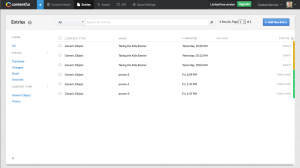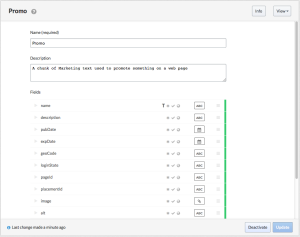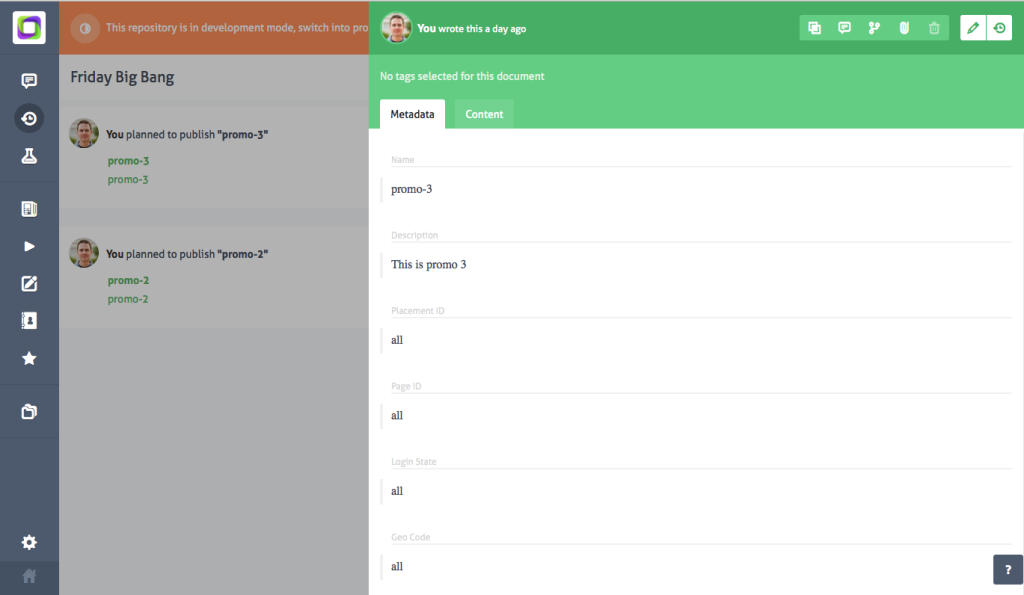 The next vendor in my Content-as-a-Service (CaaS) round-up is Cloud CMS. If you missed my overview of the CaaS market, you might want to read that first.
The next vendor in my Content-as-a-Service (CaaS) round-up is Cloud CMS. If you missed my overview of the CaaS market, you might want to read that first.
Cloud CMS has been around since 2010. It was founded by Michael Uzquiano, formerly of Alfresco, Epicentric, and Vignette. This year they brought on a new CEO, Malcom Teasdale, who, prior to joining Cloud CMS, ran Rothbury Software, an Alfresco partner that was ultimately purchased by Ixxus. Malcom spent some time at Interwoven earlier in his career. So these two have a lot of content management experience and that’s evident in their product. (Disclosure: I’ve known Michael and Malcom for several years but I do not currently have a business relationship with Cloud CMS).
My CaaS overview described functionality you’ll find in all CaaS offerings. Similar to my posts on Prismic.io and Contentful, in this post on Cloud CMS I’ll focus on some select areas of the Cloud CMS offering:
- User interface for content authors
- Creating content types
- Working with content via the API
- Security
- Pricing
Cloud CMS is an extensible platform with a long list of features. This is more than just a place to stick content and an API to get it back out–this is a full-featured CMS that happens to be running as SaaS in the cloud. But I’m primarily interested in it for its ability to act like a CaaS offering, which to me means a more pragmatic, stripped down approach to content management, so this review is going to ignore a lot of the Cloud CMS features that go beyond that. Perhaps I’ll come back to those in a future blog post.
User Interface for Content Authors
Before I describe the Cloud CMS user interface let me tell you a little about how Cloud CMS stores content. A Cloud CMS account has one or more repositories. How you use your repository is up to you–you might have one repository per project, for example.
Within a repository there are one or more branches. A branch works just like it does in source code control–it is a view of the repository. Each repository has a “master” branch, but you can have as many branches in a repository as you want. Branches can be areas where individuals work on content in isolation, or they can be for teams. Branches can never be deleted.
Within a branch are one or more changesets. Adding content to a branch (or making any change) takes place against a changeset–you’re never actually changing anything that was written previously.
And, finally, at the object level you have nodes. Everything in Cloud CMS is stored as a node. If you have a blog post, that’s a node. If your blog post points to an image, the image is also node. All nodes are typed. There are out-of-the-box types but you can also define your own. I’ll talk more about that in a bit.
Cloud CMS provides a web user interface that helps teams organize content creation built around the notion of projects. For the most part, your users see your repository through the lens of a project. They don’t have to understand the underlying structure of the Cloud CMS repository.
The first thing you see when logging in to Cloud CMS is a dashboard. From here you can manage your projects, tasks, members, and workflows. For my review I created a project called “My Cloud CMS Project”.
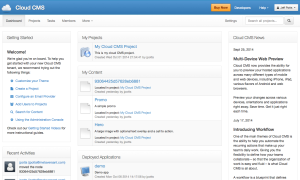 Drilling into the project displays the project’s dashboard. Clicking on Documents shows a hierarchical view of folders and documents. Multiple files can be dragged-and-dropped which triggers an upload to the folder. As you can see in the screenshot below, thumbnails are automatically created and displayed in the document list.
Drilling into the project displays the project’s dashboard. Clicking on Documents shows a hierarchical view of folders and documents. Multiple files can be dragged-and-dropped which triggers an upload to the folder. As you can see in the screenshot below, thumbnails are automatically created and displayed in the document list.
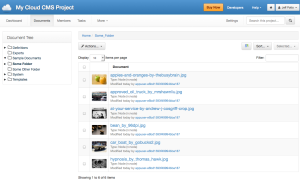 Clicking a specific document opens the details page for that object where users can edit the properties of the object, make comments, assign tags, start workflows, and perform a number of other actions.
Clicking a specific document opens the details page for that object where users can edit the properties of the object, make comments, assign tags, start workflows, and perform a number of other actions.
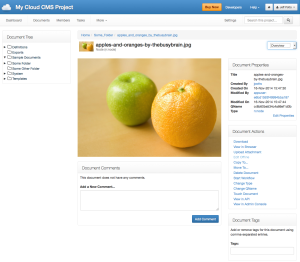 So that’s how content authors manage content in Cloud CMS. Let’s take a look at how the content model is defined.
So that’s how content authors manage content in Cloud CMS. Let’s take a look at how the content model is defined.
Creating Content Types
Content Type definitions are created using JSON Schema. You can define types using either the Cloud CMS UI by typing your JSON Schema into a web form, or by using the API. I really like the ability to define a content type simply by typing the JSON Schema that defines it. Of course, the trade-off is that you have to know how to define a type using JSON Schema. Fortunately, there is documentation that can help.
Content modeling in Cloud CMS is much more advanced than what I’ve seen in other CaaS offerings. Three examples of that are: hierarchical content models, aspect-orientedness, and role-based form definitions.
The first one, hierarchical content model, is easy to grasp: Your types can inherit from parent types. This can potentially save you time setting up your content model if your types lend themselves to being organized in a hierarchy.
The second one requires a little more explanation: aspect-orientedness. A content model is aspect-oriented when it has the ability to define bundles of properties that can be “attached” to objects, regardless an object’s underlying type. In Alfresco these are called “aspects”, in CMIS these are called “secondary types”, and in Cloud CMS these are called “features”.
For example, you might have a set of metadata that you want to track for anything that is “client-related” like the client’s name, industry, size, and primary contact. In Cloud CMS you define that set of metadata as the “client-related” feature, and then any object can become “client-related” just by adding the client-related feature–the bundle of properties having to do with a client–to the object.
The third advanced content model-related feature in Cloud CMS is role-based forms. When you create instances of a content type, Cloud CMS looks at the schema and generates a default form, similar to how other CaaS offerings work. What’s different is that Cloud CMS allows you to define multiple forms for the same content type. You can tie forms to specific roles so that different people see different authoring forms depending on their role. This is helpful when you have different types of people who need to edit the same content–you can use role-based forms to structure the form the way it makes the most sense for each type of user.
By the way, like content type definitions, form definition is also JSON-driven. Cloud CMS leverages the open source AlpacaJS forms engine into their product, which you might want to consider for your own projects, even if you don’t need Cloud CMS.
Working with Content via the API
Cloud CMS can host your application for you. This makes it nice for people who are looking for a one-stop shop for their content-centric mobile and web applications because you don’t need separate services for your content and your app. If you look back at the project dashboard screenshot I showed earlier you’ll see an example–I’ve created an application called “demo”.
What wasn’t obvious to me initially is that even if you are going to host your application elsewhere, you still need to create an application, and within that, a deployment. That’s where you’ll find the API keys needed to work with the API.
In addition to the API keys you’ll need to know your repository ID (which you can get from the Cloud CMS admin console). If you are going to fetch content from anything other than the master branch you also need the branch ID. Once you have that, querying for nodes is straightforward, as shown in this gist:
(Can’t see the code? Click here).
Under the covers, Cloud CMS is running MongoDB and Elasticsearch. So when you query for Nodes, you’re using Mongo. When you’re searching the full-text of your nodes you’re using Elasticsearch.
Everything in Cloud CMS is stored in JSON so creating content is as simple as calling createNode and passing in JSON for the property values:
(Can’t see the code? Click here).
Security
Every object in Cloud CMS can have an ACL and child objects can inherit ACLs from their parents. There are out-of-the-box roles you can use in those ACLs, including: Connector, Consumer, Contributor, Editor, Collaborator, and Manager. Unfortunately, to set permissions on an object you have to switch from the project user interface to the administrative user interface. Still, this is the only vendor in the round-up offering object-level permissions.
Pricing
Cloud CMIS offers a free 14-day trial. After that you have to switch to one of four monthly plans:
- Starter: $20/month. Limited to a single project and email support.
- Platform: $200/month. Unlimited projects and email support.
- Premium: $800/month. Unlimited projects, phone support, developer support, additional AWS features
- Enterprise: $2400/month. Private cloud with an on-premises option
The ability to run the entire stack on-premises is an interesting option for those not ready for the cloud although I haven’t explored how practical that really is for Cloud CMS.
The usual caveats apply to pricing here. Like other CaaS offerings, Cloud CMS places limits on total storage space and data transfer so look at the details to make sure you understand what this will cost you each month.
Overall Impressions
Cloud CMS is a full-featured platform for content management. Where some startups focus on the minimum viable product, Cloud CMS has gone for a kitchen sink approach that approximates the functionality you might expect in more mature, on-premises ECM offerings. Cloud CMS can even be the platform that runs your application, if that’s what you need.
Content management professionals will appreciate the advanced content modeling and forms features, which is just one example of functionality that reflects the founders’ ECM industry heritage. The flip-side of that coin, however, is the complexity also reminiscent of those systems. The documentation and tutorial videos help but there is a learning curve here.
Cloud CMS can compete against CaaS players like Prismic.io and Contentful as well as established ECM vendors like Alfresco and Documentum. Compared to other CaaS players it has much richer functionality, but it is also more complicated to use. To compete against them successfully Cloud CMS may need to further streamline the UI so that users can harness that power without being overwhelmed by other features.
Compared to established vendors like Alfresco and Documentum, Cloud CMS offers a hosted system running in the cloud with a similar feature list while maintaining the ability to customize the platform. Customers looking to move to the cloud may find an easier migration to Cloud CMS than to one of the newer CaaS players. In this respect Cloud CMS also competes with other traditionally on-prem document management offerings now offered in the cloud like Hippo onDemand and Nuxeo Cloud.
With two ECM veterans at the helm and impressive functionality it will be interesting to watch Cloud CMS go after one or both of these markets.

 It’s time for the next vendor in my Content-as-a-Service (CaaS) round-up. In this post I’ll be taking a look at
It’s time for the next vendor in my Content-as-a-Service (CaaS) round-up. In this post I’ll be taking a look at 